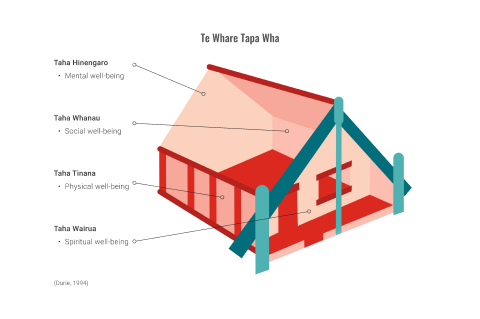A holistic approach to neurodiversity involves viewing individuals in their entirety, rather than solely through the lens of their diagnosis. It entails recognising and understanding their strengths and challenges. Unlike conventional medicine, which frequently concentrates solely on symptoms, this approach considers a person's physical, emotional, mental, and social well-being. It recognises that each person is unique and needs personalised support and care, moving away from a one-size-fits-all approach.
When considering how different cultures view health, Hauora, a Māori philosophy, provides valuable insights. It emphasises four dimensions:
- Taha Tinana (Physical Dimension): Focuses on physical health, growth, and development. Emotional stress or illness can affect the body, and bodily sensations communicate information about well-being.
- Taha Hinengaro (Mental Dimension): Centres on psychological health, acknowledging the connection between the mind and body. Emotional well-being is considered more meaningful than verbal communication.
- Taha Whānau (Family Dimension): Highlights the importance of family as the fundamental unit of Māori society, providing strength and identity. Family plays a crucial role in both contributing to and curing illness.
- Taha Wairua (Spiritual Dimension): Emphasises spiritual awareness as essential for health. Traditional Māori analysis of illness considers the spirit, recognising unseen energies.
Each dimension influences the others, and if any is missing or damaged, it can lead to imbalance and illness. Modern health services may overlook the spiritual dimension in traditional Māori approaches.
Sir Mason Durie's Te Whare Tapa Whā model, developed in 1984, reinforces this holistic concept. It compares well-being to a wharenui or meeting house, with each of its four walls representing a different dimension of holistic health. This model, deeply rooted in Māori perspective, provides valuable insights applicable to diverse populations. The wharenui metaphor shows that each dimension is integral to overall well-being, emphasising the interconnectedness of physical, mental, family, and spiritual aspects.

Share - Holistic Health Models Forum
- Choose a holistic health model from your own culture or one you find interesting (e.g. Ayurveda, Te Wheke, Fonofale, Fonua, Ying Yang, Rudolf Steiner).
- Summarise this model, highlighting its important ideas about well-being.
- Explain how the principles of this cultural health model could support those in the neurodiverse community.
- Find out if there are any special practices or traditions in this model that might make a more welcoming and helpful space for neurodivergent individuals.
- Share what you discover about how using parts of this cultural health model might help us understand and support neurodiverse communities better on the class forum.
- List all references used.
This short reading also looks at the concept of a 'person-centred' or holistic approach, with a focus on placing the individual at the centre of plans and interventions, in contrast to the disease-oriented 'medical model’. This approach aligns with the biopsychosocial model, which considers the interconnected elements of body, mind, and environment in determining health and well-being.
The reading gives an example of someone who faces difficulties in mathematics due to neurodivergent traits, and how it affects the way they see themselves and their mood. It stresses the importance of not just solving specific problems but also considering the bigger picture, including the environment and how society views them.
A person-centred approach believes that to improve health and well-being, we need to fully understand and support each person in all aspects of their life.
Reading
Neurodiversity 101: Taking a Person-Centred Approach
Expected Duration: 5 minutes
Reading: Neurodiversity 101: Taking a Person-Centred Approach
Post-Read Task
Answer the following questions:
- Describe the role of a bio/psycho/social approach in understanding an individual's health and wellbeing (i.e. the interaction between body, mind, and social environment.)
- What are some problems that could arise with the person-centred approach, especially when compared to the traditional medical model? Are there times when using the medical model might be better?
We've been talking about ways to support neurodiversity from cultural perspectives and a person-centred approach. Now, let's get more practical!
Promoting a holistic approach to living well with neurodiversity involves recognising the interconnectedness of various factors. Physical exercise, maintaining a healthy diet, and ensuring sufficient sleep can significantly contribute to mental well-being.
Additionally, finding outlets for self-expression and relaxation through personal interests, such as arts, music, or nature, also plays a crucial role in fostering overall holistic well-being.
Explore the impact of sleep, diet, and exercise on neurodiversity in the following exercise.
Occupational therapists (OTs) play a crucial role in supporting individuals with ADHD and other neurodivergent conditions. They adopt a holistic approach, focusing on how these conditions impact daily activities and independence. OTs tailor intervention plans to enhance self-regulation, executive functioning skills, and sensory processing capabilities.
Strategies may include creating routines, using visual aids, and addressing sensory overload. Working collaboratively with families and healthcare providers, OTs advocate for modifications in home, school, or work environments to meet individual needs and foster well-being. Additionally, OTs provide guidance on lifestyle modifications, mind-body interventions, and environmental adjustments to support holistic health.
Autistic burnout is a state of physical, emotional, and mental exhaustion, often triggered by stress, sensory overload, social challenges, or difficulties in navigating systems. It involves chronic fatigue, heightened sensitivity to stimuli, and a decline in executive functioning skills, impacting daily functioning and overall well-being.
Read about Sarah’s recovery from autistic burnout and think about how you could use some of her methods to help yourself or others in a similar situation.
Case Study
Sarah's Journey Through Autistic Burnout

Sarah is a 30-year-old autistic woman who works as a graphic designer. She is highly skilled and passionate about her work, often immersing herself in creative projects for hours on end. However, recently, Sarah has been feeling overwhelmed and exhausted, both physically and emotionally.
Background: Sarah's burnout was triggered by a combination of factors. Her job requires intense focus and attention to detail, which can be draining for someone with sensory sensitivities. Additionally, Sarah has been experiencing challenges in her personal life, such as difficulties in social interactions and pressure to conform to societal expectations.
Symptoms: Sarah's autistic burnout manifested in various ways. She experienced chronic fatigue, finding it increasingly difficult to get out of bed in the morning. She became hypersensitive to sensory stimuli, finding loud noises and bright lights unbearable. Sarah also struggled with executive functioning, finding it hard to concentrate and make decisions.
Holistic Approach to Recovery: To recover from her burnout, Sarah decided to take a holistic approach, incorporating various strategies into her daily life:
- Rest: Sarah prioritised rest, ensuring she got enough sleep each night and taking short breaks throughout the day to recharge.
- The Great Sieve: She practiced "The Great Sieve," a mindfulness technique that helped her filter out overwhelming stimuli and focus on what was truly important.
- Boundaries: Sarah set clear boundaries in her personal and professional life, learning to say no to tasks that would overextend her.
- Medication: With the guidance of her healthcare provider, Sarah started taking medication to help manage her anxiety and improve her mood.
- Animals: Sarah found comfort in spending time with her pets, who provided her with unconditional love and support.
- Affirming or Nothing: She practiced affirmations and positive self-talk, reminding herself of her worth and capabilities.
- Self-Love/Inner Child: Sarah focused on self-love and nurturing her inner child, engaging in activities that brought her joy and comfort.
- Healthy Fixations: She channeled her energy into healthy fixations, such as her work and hobbies, finding solace in her creative pursuits.
- Work out Masking: Sarah learned to recognise when she was masking her autistic traits and allowed herself to be authentic and true to herself.
- Be Honest with Yourself: She practiced honesty with herself, acknowledging her limits and seeking help when needed.
Outcome: Through her holistic approach, Sarah gradually began to feel better. She noticed improvements in her energy levels, mood, and overall well-being. Sarah also found that her creative abilities flourished when she allowed herself to rest and recharge.
Reflection
Reflect on a time when you or someone you know experienced burnout or extreme stress. How did you or they cope with the situation? Were any holistic approaches similar to those used by Sarah employed? If not, how might incorporating such approaches have changed the experience? Share your thoughts in a brief reflection (150-200 words) on the forum.
- Holistic neurodiversity perspective emphasises the whole person, not just the diagnosis.
- Cultural perspectives like Hauora and Te Whare Tapa Whā underscore physical, mental, family, and spiritual dimensions.
- Person-centred approach contrasts with the medical model, considering broader factors for support.
- Holistic well-being integrates sleep, diet, exercise, and personal interests for neurodiversity support.
- Occupational Therapy adopts a holistic approach, addressing neurodivergent impact on daily activities.
- Autistic burnout recovery includes strategies like rest, boundaries, medication, animals, and self-love.
